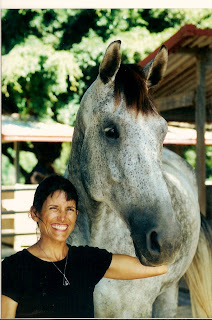When I first introduced Dr. Cook's bitless bridle to my horses, the look on their face was just amazing. It was one of surprise and relief. For many years, I struggled with trying different bits on my horse because he clearly showed anxiety when being bridled and became extremely nervous and agitated. As time went on, this behavior got worse. Eventually, he began exhibiting lameness only when bridled. When lungeing with side reins he was a nervous wreck and the entire time of riding, even just standing on a loose rein he was fussing and clucking with the bit as if trying to spit it out.
The first time bridling him with the bitless bridle, the conditioned behaviors started and as soon he realized there was no bit, he immediately stopped fussing and stood very quiet. He even lowered his head into the bridle and was completely cooperative.
 From my experiences with Dr. Cook's bitless bridle, the horses respond to it positively. It is as if they are stripped naked of all the evasions and now they can put their energy into working and traveling straight and correct with no pain. It takes time to redo the negative behaviors that were created by the bit. The horse becomes conditioned that the bit causes pain and is something to get away from, therefore the evasions are created out of self preservation. They bulge their shoulders to either side, plow through your aids, track crooked, run, bolt, grab it and buck, pull the reins out the riders hands, bite down on the bit, curl behind it, break at the poll, cock their head, the list of evasions to the bit is endless.
From my experiences with Dr. Cook's bitless bridle, the horses respond to it positively. It is as if they are stripped naked of all the evasions and now they can put their energy into working and traveling straight and correct with no pain. It takes time to redo the negative behaviors that were created by the bit. The horse becomes conditioned that the bit causes pain and is something to get away from, therefore the evasions are created out of self preservation. They bulge their shoulders to either side, plow through your aids, track crooked, run, bolt, grab it and buck, pull the reins out the riders hands, bite down on the bit, curl behind it, break at the poll, cock their head, the list of evasions to the bit is endless. The retraining comes naturally as they begin to learn there is no reason to travel crooked, it is safe to move into the bridle and there is no pain. For years we struggle with trying to teach the horse to get on our seat and leg aids and move forward into the 'bit'. Steady hands are most important to not inflict pain and cause the horse to evade the contact. Most of us are not olympic riders and although we do our best with quiet hands and seat, there are still times when we may pull or jerk on the reins, even a little bit, causes the horse to suck behind the aids, curl, tuck their nose, overbend etc.
 With the bitless bridle the horse is more than happy to move forward into the bridle and they will do so in a correct frame because they are allowed to do this without something inhibiting their natural movement. I have found there is more control and more sensitivity with the bitless bridle. The horse responds immediately and understands the request.
With the bitless bridle the horse is more than happy to move forward into the bridle and they will do so in a correct frame because they are allowed to do this without something inhibiting their natural movement. I have found there is more control and more sensitivity with the bitless bridle. The horse responds immediately and understands the request. A horse that overbends, which is often a difficult problem to correct because they are tucking behind the aids and tucking their nose behind the bit, will easily move up into the bitless bridle and stop overbending. I have found you can collect, lengthen, leg yield, half pass, etc more correctly with the bitless bridle because it allows the horse the freedom to do so.
The more I work with the bridle with different horses, the more impressed I am at how natural the response is from the horse and how quickly they catch on. The aids for the rider remain the same, most importantly coming from the seat and legs and then into the bridle. Halting is immediate. The signals with the reins are light yet the response is quick and precise. It improves your communication with the horse.
There are several companies making bitless bridles as they have become more and more popular. I have not worked with other brands of bitless bridles other than Dr. Cook's so I cannot attest to their effectiveness. I am extremely impressed with Dr. Cook's bitless bridle.
If you are still sitting on the fence about trying it, afraid you won't have control. You have more control and a happy horse. Give it a try, your horse will love you for it.



